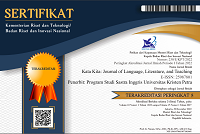Iron Man’s and Captain Marvel’s Anxieties and Defense Mechanisms in “Civil War II”
DOI:
https://doi.org/10.9744/katakita.6.1.98-104Keywords:
Android, DVR, GPS, Google Maps, Live Streaming, Wowza Streaming Engine, RTMP, RTSPAbstract
This thesis deals with the anxieties experienced by the leaders of superhero teams in Civil War II, Iron Man and Captain Marvel. Through their anxieties in Civil War II, I tried to reveal the causes of their anxieties and their ways to reduce these uneasy feelings. To analyze the causes of these two characters’ anxieties, I used two of the theory of anxiety, reality and moral anxiety. I found that there are two causes that make Iron Man feel anxieties which are the reaction of Captain Marvel towards Ulysses’ prophecies and his responsibility both as a superhero and as a leader to protect people from the outcome of Ulysses’ prophecies. On the other hand, Captain Marvel also feels anxieties from the blame of Iron Man and her responsibility both as a superhero and as a public officer to protect people from dystopian future. Iron Man uses two defense mechanisms, which are splitting and rationalization. On the other hand, Captain Marvel also uses two defense mechanism, which are idealization and rationalization. These defense mechanisms are used by both, Iron Man and Captain Marvel to ease their reality and moral anxiety.
References
Andrews, T. M. (2016, July 12). The resurgence of comic books: The industry has its best-selling month in nearly two decades. Retrieved July 2, 2017, from The Washington Post: https://www.washingtonpost.com/news/morning-mix/wp/2016/07/12/the-resurgence-of-comic-books-the-industry-has-its-best-selling-month-in-nearly-two-decades/?utm_term=.3d0c1bc6c181
Bendis, B. M. (2016). Civil War II Vol 1 (Vol. I). Marvel Comics.
Bendis, B. M. (2016). Civil War II Vol 3 (Vol. III). Marvel Comics.
Bendis, B. M. (2016). Civil War II Vol 4 (Vol. IV). Marvel Comics.
Bendis, B. M. (2016). Civil War II Vol 6 (Vol. VI). Marvel Comics.
Bendis, B. M., & Oeming, M. A. (n.d.). Powers. Retrieved June 1, 2017
Bouras, .., & Holt, .. (2007). Psychiatric and Behavioural Disorders in Intellectual and Developmental Disabilities (2nd ed.). Cambridge University Press. Retrieved November 22, 2017
Carser, D. (1979). The defense mechanism of splitting: Developmental origins, effects on staff, recommendations for nursing care. Journal of psychiatric nursing and mental health services. Retrieved November 18, 2017
Ching, A. (2014, July 23). "Brian Michael Bendis Helps Aspiring Comics Pros Write Words for Pictures". Retrieved June 18, 2017, from Comic Book Resources: http://www.cbr.com/brian-michael-bendis-helps-aspiring-comics-pros-write-words-for-pictures/
Freud, S. (1923). The ego and the id.
Goin, M. K. (1998, November 01). Borderline Personality Disorder: Splitting Countertransference. Psychiatric Times, 15(11). Retrieved September 28, 2017, from Psychiatric Times: http://www.psychiatrictimes.com/borderline-personality/borderline-personality-disorder-splitting-countertransference-0
Gustines, G. G. (2014, July 20). Comics Sales Rise, in Paper and Pixels. Retrieved July 10, 2017, from The New York Times: https://www.nytimes.com/2014/07/21/business/media/comics-sales-rise-in-paper-and-pixels.html?_r=0
Hall, C. (1999). A Primer of Freudian Psychology. New York: NAL PENQUI INC.
Lerner, P., & Van-Der Keshet, Y. (1995, August). A note on the assessment of idealization. Journal of Personality Assessment, 77-90. Retrieved September 29, 2017
McWilliams, N. (1992). Ego Mechanisms of Defense: A Guide for Clinicians and Researchers. American Psychiatric Publishing, 238. Retrieved September 29, 2017
Miller, J. J., & Griepp, M. (2016). Retrieved June 12, 2017, from Comichron: http://www.comichron.com/yearlycomicssales/industrywide/2016-industrywide.html
Scharter, D. (2011). Psychology (2nd ed.). New York: Worth Publisher. Retrieved November 25, 2017
Downloads
Issue
Section
License
Authors who publish with this journal agree to the following terms:- Authors retain copyright and grant the journal right of first publication with the work simultaneously licensed under a Creative Commons Attribution License that allows others to share the work with an acknowledgement of the work's authorship and initial publication in this journal.
- Authors are able to enter into separate, additional contractual arrangements for the non-exclusive distribution of the journal's published version of the work (e.g., post it to an institutional repository or publish it in a book), with an acknowledgement of its initial publication in this journal.
- Authors are permitted and encouraged to post their work online (e.g., in institutional repositories or on their website) prior to and during the submission process, as it can lead to productive exchanges, as well as earlier and greater citation of published work (See The Effect of Open Access).














